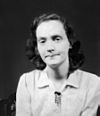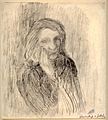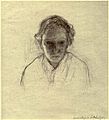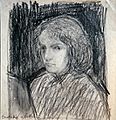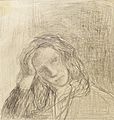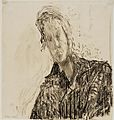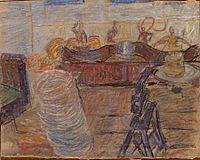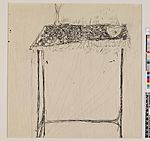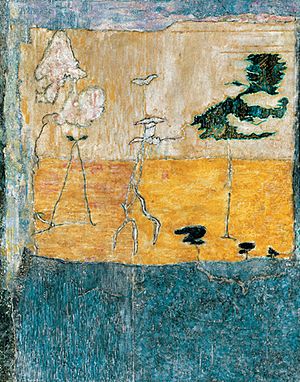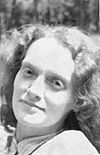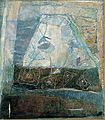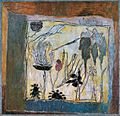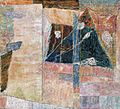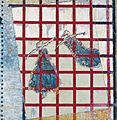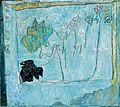Ilka Gedő facts for kids
Quick facts for kids
Ilka Gedő
|
|
|---|---|
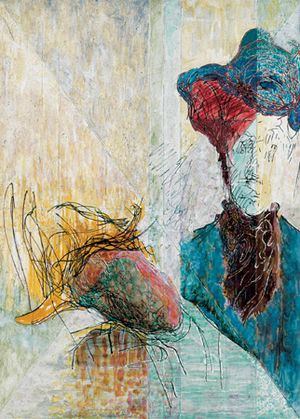
Double Self-Portrait, 1985, Oil on photographic paper laid down on canvas, 58 x 42 cm
|
|
| Born |
Gedő Ilka
June 26, 1921 Budapest, Hungary
|
| Died | 19 June 1985 (aged 63) Budapest, Hungary
|
| Nationality | Hungarian |
| Education | Self-taught, private schools Budapest |
| Known for | Painting, drawing |
|
Notable work
|
approximately 3,500 drawings and 152 paintings |
| Movement | Expressionism, Modern Art |
| Spouse(s) | Endre Bíró |
Ilka Gedő (May 26, 1921–June 19, 1985) was a talented Hungarian painter and graphic artist. Her art survived through tough times when Hungary was ruled by strict governments. First, there was a government that was a bit like a dictatorship in the 1930s and 1940s. Then, after a short period of freedom (1945-1949), a communist government took over.
In the first part of her career, which ended in 1949, she made many drawings. Later, starting in 1964, she began painting with oils. People say Ilka Gedő was a unique artist. Her special way of creating art means she can't really be compared to anyone else.
Contents
Early Life and Art Training
Ilka Gedő was born in Budapest, Hungary, on May 26, 1921. Her father was a teacher, and her mother was a clerk. Their family knew many famous Hungarian writers and artists. Ilka grew up in a home where she had every chance to become a skilled and thoughtful artist. She went to a school called Új Iskola (New School), which had new and exciting ways of teaching.
From a very young age, Ilka Gedő was always drawing. She used her drawings to record everything she experienced. The drawings from her childhood are still kept today. They are like a visual diary, showing her life as she grew up.
When she was seventeen, Ilka spent her holidays in the Bakony hills, near Budapest. She spent all her time drawing the beautiful scenery. She even followed farmers as they cut grass, drawing their movements over and over to capture the rhythm. Even though she hadn't had much formal training, her drawings and watercolors from 1937-1938 show that she was already a master at drawing.
From the late 1930s to the early 1940s, Ilka Gedő learned from three Jewish artists. Sadly, these teachers were later killed by the Nazis during the war. In 1939, she attended an open art school run by Tibor Gallé. Her second teacher was Victor Erdei, a painter known for his realistic and Art Nouveau styles. Her third teacher was the sculptor István Örkényi Strasser. From him, Ilka learned how to make her drawings feel solid and three-dimensional, like sculptures.
After finishing school, Ilka Gedő wanted to study art in Paris. But World War II started, and new laws against Jewish people meant she couldn't go to the Hungarian Academy of Art either. These laws, put in place by the Hungarian Fascists (the Arrow Cross Party), made it very hard for Jewish people to live normal lives.
During the war, Ilka made money by creating ceramics. But she never stopped drawing. She often visited Szentendre, a small town by the Danube River, which was a haven for artists. From 1938 to 1947, she made colorful pastel drawings of the town, using bright reds, yellows, browns, blues, and greens.
In the early 1940s, Ilka also visited the studio of Gyula Pap, a former student of the famous Bauhaus art school. During these years, until 1944, Ilka Gedő made many detailed pencil drawings of her family life. She also started a series of self-portraits, which she continued until 1949. In 1942, she showed her work in an exhibition called "Freedom and the People," organized by a group of socialist artists.
Art from the Budapest Ghetto
On March 19, 1944, German soldiers invaded Hungary. This started a terrible time for Hungarian Jews. Many were sent to concentration camps where they were killed. Around 200,000 Jews were forced into the Budapest Ghetto or special houses. Ilka Gedő was lucky and managed to survive.
In the Budapest Ghetto, Ilka Gedő spent her time reading and drawing. She drew her surroundings, the people she was with, the elderly, and the children. These drawings are important records of that time. They also show the sadness and helplessness people felt. In one self-portrait, she looks directly at the viewer, showing a person who has lost control of her own life. She seems to have no age or gender, just a raw human experience.
In her last drawing from this period, she shows herself with a drawing board. Her eyes seem to stare into nothingness. It's like she's looking inside herself for strength.
Art After the War (1945-1948)
Self-Portrait Drawings (1945–1949)
On New Year's Eve 1945, Ilka Gedő met Endre Bíró, who would later become her husband. He was a chemistry student who worked for a famous Hungarian scientist. Ilka needed people to draw, and she often used herself as a model.
Ilka Gedő created self-portraits that are very honest and show deep self-discovery. These drawings look real and also show strong emotions. However, she started to doubt if she could truly capture reality. Her usual calm and structured drawing style slowly changed to a more energetic and intense one.
Her self-portraits from the Fillér utca series are very powerful because of their raw honesty.
The Ganz Factory Drawings (1947–1948)
Always looking for new things to draw, Ilka found the Ganz Machine Factory, near her home, to be a very interesting place. She got permission to visit the factory through an artists' union.
Just like her self-portraits from this time, her drawings and pastels of the Ganz Factory are quick sketches. They show her strong focus and expressive talent. The shaky lines in her drawings show how she felt about the industrial work. Ilka Gedő didn't draw the factory for political reasons, and she didn't try to make it look perfect. Instead, she showed dramatic views of the huge factory spaces and also caring studies of the tired workers. Her Ganz Factory drawings are realistic, but they are also very emotional. In these works, the large spaces and objects seem to make the people look small and almost like simple shapes.
Table Series (1949)
The subject of these drawings is a simple, everyday table that was always nearby. The lines in these drawings are not just outlines. They move and create a sense of mysterious energy.
A Time of Silence (1949–1965)
During this time, from 1945 to 1949, very few people saw Ilka Gedő's drawings. She also started using oil paints, but she destroyed most of these early oil paintings when she felt very sad and unsure about her art.
After a period of freedom, a communist government took control in Hungary in 1948. This greatly affected Ilka Gedő's life and was one reason she stopped making art for sixteen years. In 1949, Ilka Gedő stopped painting and drawing completely. She didn't pick up a pencil or brush again until 1965, not even to play with her children. It's rare for an artist who loves art so much to stop creating without being forced.
There were three main reasons she stopped. First, the new communist government made things difficult. Second, her art wasn't recognized by others. Many of her friends preferred abstract art and didn't like her realistic style, seeing abstract art as a way to express political ideas. Third, Ilka Gedő felt that to stay true to her artistic self, she had to stop creating for a while.
Even though she stopped making art, Ilka Gedő didn't give up on it entirely. She spent a lot of time studying art history and color theory. She read and took notes on Goethe's "Theory of Colours," even translating parts of it. These studies were very important for the colorful paintings she would create later.
In the mid-1960s, she carefully organized almost all her earlier drawings into folders. Her first solo art show was a small exhibition in her studio on May 15, 1965, showing drawings from 1945 to 1948.
By the early 1960s, the communist government's control over society became a little less strict. But Ilka Gedő still felt isolated. Many of her friends made deals with the government, while younger artists became famous in other countries. In the last two years of the war and the four years of freedom after 1945, Ilka Gedő created many drawings. But their existence was mostly forgotten until she had her first public exhibition in 1980, when she was 59 years old.
Later Paintings
In the 1960s, Ilka Gedő started painting with oil. She had a special "two-step" way of painting. First, she would draw a sketch of her idea. Then, she would make a plan, writing down the names of the colors she wanted to use in different areas. She even had a collection of color samples. She never just made things up as she painted. Instead, she carefully followed her original plan, making it larger on the canvas. In her paintings, strong cool colors and warm colors seem to balance each other. She painted slowly and thoughtfully, writing down every step of her creative process in diaries. This means we can trace how each painting was made.
Her diary entries show all her thoughts about making a painting. When she put a painting aside, she would put away its diary and work on another. Before starting a painting again, she always read her old notes.
Her way of creating art followed her feelings but also used her intellect. Art critics have noticed that her work sometimes reminds them of older art styles like Art Nouveau. But Ilka Gedő was really looking for a "lost mythology" or a special, personal story in her art. She found this in art itself, which could bring back memories of a world that was in danger.
A well-known Hungarian art historian, László Beke, said in 1980 that it was pointless to compare her art to "modern" trends. He felt her art could have been created at any time between 1860 and 2000. He said her art came from "inside" her, not from outside influences. Its strength and truth came from her connection to her art, which anyone looking at her work could see.
Ilka Gedő passed away on June 19, 1985, at the age of 64. This was just a few months before her art became well-known outside of Hungary. Her breakthrough happened in Glasgow, Scotland, where the Compass Gallery showed her paintings and drawings in 1985.
Timeline of Ilka Gedő's Life
- 1921: Ilka Gedő was born on May 26 in Budapest.
- 1939: She attended the free art school of Tibor Gallé.
- 1940: She showed her art in the second exhibition of OMIKE (Hungarian Jewish Educational Association).
- 1939-42: She learned from Victor Erdei.
- 1942: She took part in an exhibition by the Group of Socialist Painters.
- 1942-43: She attended the free school of István Örkényi-Strasser.
- 1943: Gedő participated in the fifth OMIKE exhibition.
- 1944: She created her famous Budapest ghetto drawings.
- 1945: In the fall, Ilka Gedő enrolled in the Academy of Fine Arts but left after six months. She also drew at Gyula Pap's school.
- 1946: She married the biochemist Endre Bíró.
- 1947: Her first son, Dániel, was born.
- 1949: She stopped her artistic work.
- 1950: From this year on, she didn't participate in the art world. She focused on studying art history, philosophy of art, and color theory. She translated parts of Goethe's theory of color.
- 1953: Her second son, Dávid, was born.
- 1962: The Hungarian National Gallery bought three of her drawings.
- 1965: She had a studio exhibition of her drawings from 1945-1949. She started making art again.
- 1969-1970: She spent a year in Paris and took part in a group exhibition at the Galerie Lambert.
- 1974: She became a member of the Association of Visual Artists.
- 1980: A large exhibition of her work was held at the St. Stephen's Museum in Székesfehérvár, Hungary.
- 1982: An exhibition was held at the Dorottya Gallery in Budapest. The National Gallery of Hungary bought two of her paintings.
- 1985: Gedő passed away on June 19 in Budapest. A solo exhibition of her art opened in the Gallery of the Szentendre Art Colony. Another solo exhibition of Ilka Gedő's work was organized in Glasgow, Scotland, which received a lot of attention from the British press.
Exhibitions
Solo Exhibitions in Hungary
- Studio Exhibition (1965)
- King St. Stephen's Museum, Székesfehérvár, Hungary (1980)
- Dorottya Utca Gallery, Budapest (1982)
- Artists' Colony Gallery, Szentendre, Hungary (1985)
- Palace of Exhibitions, Budapest (1987)
- Gallery of Szombathely (1989)
- Hungarian Jewish Museum, Budapest (1995)
- Budapest Municipal Picture Gallery, Museum Kiscell (2001)
- Raiffeisen Gallery (2003–2004)
- Hungarian National Gallery (2004–2005)
- Hungarian National Theatre (2013)
- Museum of Fine Arts - Hungarian National Gallery (2021)
Solo Exhibitions Abroad
- Compass Gallery, Glasgow (1985)
- Third Eye Centre, Glasgow (1989)
- Janos Gat Gallery, New York (1994 and 1997)
- Shepherd Gallery, New York (1995)
- Collegium Hungaricum, Berlin (2006)
Group Exhibitions (a selection)
- 1940: Second Exhibition of OMIKE, Jewish Museum, Budapest
- 1943: Fifth Exhibition of OMIKE, Jewish Museum, Budapest
- 1942: Freedom and the People, Metalworkers' Trade Union, Budapest
- 1945: Exhibition of the Society of Artists of the Social Democratic Party, Ernst Museum, Budapest
- 1947: The Second Free National Exhibition of the Free Organization of Hungarian Artists, Municipal Gallery of Budapest
- 1964: The Group of Socialist Artists, 1934-1944, National Gallery, Budapest (Memorial Exhibition)
- 1995: Culture and Continuity: The Jewish Journey, Jewish Museum, New York
- 1996: From Mednyánszky to Gedő—A Survey of Hungarian Art, Janos Gat Gallery
- 1995: Victims and Perpetrators–Ilka Gedő’s Ghetto Drawings and György Román’s Drawings at the Trial of War Criminals, Hungarian Jewish Museum
- 1996: Victims and Perpetrators /Ilka Gedő’s Ghetto Drawings and György Román’s Drawings at the War Criminal Trials, Yad Vashem Art Museum, Jerusalem
- 1997-1998: Diaspora and Art, Hungarian Jewish Museum, Budapest
- 1998: The Levendel Collection, Municipal Museum of Szentendre
- 1999: Voices from Here and There (New Acquisitions in the Departments of Prints and Drawings), Israel Museum, Jerusalem
- 2000: Directions, Fall Season 2000, Janos Gat Galley, New York
- 2002: Alternative Hungarian Workshop Schools of the 20th Century, joint exhibition of the Lajos Kassák and Viktor Vasarely Museums
- 2003: Nineteenth Century European Paintings Drawings and Sculpture, Shepherd Gallery, New York
- 2003: The Right of the Image: Jewish Perspectives in Modern Art, Museum Bochum
- 2004: The Forgotten Holocaust, Palace of Art, Budapest
- 2005: The Holocaust in Fine Arts in Hungary, Collegium Hungaricum, Berlin
- 2014: Dada and Surrealism. Magritte, Duchamp, Man Ray, Miró, Dalí. A Selection from the Collections of the Israel Museum, joint exhibition of the Israel Museum and the National Gallery, Budapest
- 2016: Kunst aus dem Holocaust, Deutsches Historisches Museum, Berlin
- 2019: In the Best Company—Selected New Acquisitions of the Berlin Kupferstichkabinett, 2009-2019, Kupferstichkabinett (Museum of Prints and Drawings), Berlin
- 2023: Of Mystic Worlds, Drawing Center, New York
Where to Find Her Art (Public Collections)
You can find Ilka Gedő's artworks in many museums and galleries around the world, including:
- The Hungarian National Gallery, Budapest
- The Hungarian Jewish Museum, Budapest
- The King St. Stephen's Museum, Székesfehérvár, Hungary
- The Yad Vashem Art Museum, Jerusalem
- The Israel Museum, Jerusalem
- The British Museum, Department of Prints and Drawings
- The Museum Kunst Palast, Düsseldorf, Department of Prints and Drawings
- The Jewish Museum, New York
- The Kupferstichkabinett (Museum of Prints and Drawings), Berlin
- The Albright-Knox Art Gallery, Buffalo, New York, USA
- The Museum of Fine Arts, Houston, Texas, USA
- The Albertina, Vienna
- The Metropolitan Museum of Art, Department of Modern and Contemporary Art, New York
- The Duke Anton Ulrich Museum, Braunschweig, Germany
- The Cleveland Museum of Fine Art
- MoMA, Department of Drawings and Prints, New York
- Städel Museum, Frankfurt am Main, Germany
Selected Oil Paintings
Oil Paintings at the Hungarian National Gallery
Oil Paintings from 1945 to 1948
Paintings Made from Pastels
Rose Garden Series
Artificial Flower Series
Circus and Other Mythical Scenes
Self-Portraits
See also
 In Spanish: Ilka Gedő para niños
In Spanish: Ilka Gedő para niños




